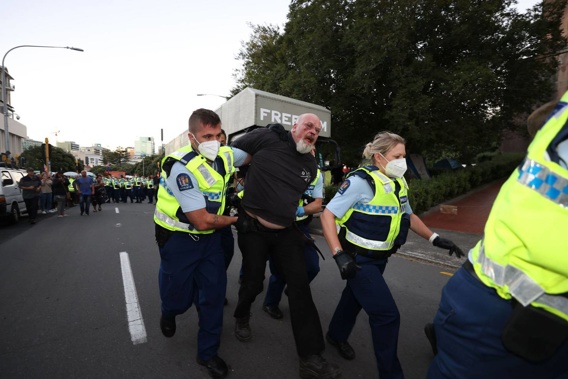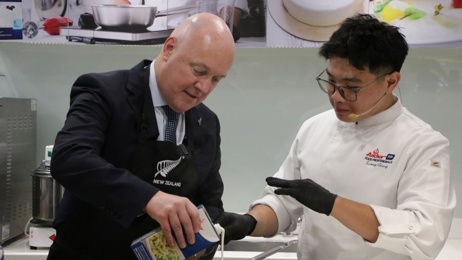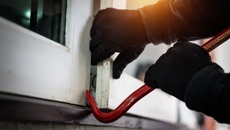
It started small.
Fewer than 100 people arrived on Parliament’s grounds on a sunny Tuesday morning two weeks ago; armed with a few flags and placards with various messages.
Some were anti-mandate. Others were anti-media. Many were anti-Government.
It caught many in Parliament by surprise. There had been talk of a convoy arriving in Wellington but aside from a few postings on social media, it was a relatively unknown entity.
Parliament Security, however, were aware and before the first wave arrived; they had put up temporary fencing to keep protesters away from Parliament’s steps and entryways.
Before long, Police had arrived. They had a presence outside but many were stationed inside the bowels of Parliament.
By the end of day one, a few people started pitching tents on the lawn – but just a few.
But more arrived the next day. Day two was when the public really started to take notice of what was going on.
Protesters had begun parking on main roads. There were lines of cars, trucks and camper vans lined up along the bottom end of Lambton Quay.
The windows of their vehicles were plastered with anti-Government messages and ‘MAGA’ (Make Ardern Go Away) signs.
Outside Parliament, more Police. A greater number inside as the size of the gathering on the lawn swelled.
At this stage, the signs and much of the rhetoric was very aggressive. Someone had scrawled ‘hang ‘em high’ on the forecourt with chalk. There were numerous references to the Nuremberg Trials and a myriad of other threats to MPs and reporters.
Some thinly veiled. Some horrifyingly direct.
Day two was when the first push came.
Rumours had been circulating that some of the protestors planned to rush the Police blockade and make their way into Parliament at 3pm that day.
At roughly twenty past three, the rumour became reality.
One protester made his way to the front of the crowd, took the microphone and announced that the time had come.
‘They can’t arrest all of us,’ he was heard saying.
They then tried to push through. It started slowly; from a distance, it looked like a small scuffle until more Police made their way to the frontline.
They linked up in a long line and held fast as the protesters pushed, and pushed.
One broke through but was quickly apprehended by Police. Then another, and another.
One of those was the man inciting the push – he spat venom at onlooking media as he was taken inside by Police.
The push died down and things settled long enough for Police to deliver a trespass notice.
The man who received the order scrunched it up and threw it in a cop’s face.
Three were arrested that day.
Overnight, more people came. More tents were set up and the grounds started to resemble a campsite.
Day three – Thursday, February 10th – will no doubt be look back on as the day everything changed.
Up until then, Police were in control of the situation. In fact, Police almost outnumbered the protesters as the sun rose behind a thick shield of grey Wellington cloud that morning.
After repelling protesters, it was the Police’s turn to advance.
Skirmishes started early, with Police moving in on the Northern end of Parliament’s grounds.
The protesters began to push back and when they did, arrests were made.
As people were being marched inside, protesters could be heard chanting “hold the line” and “freedom” as they continued clashing with Police.
The back and forth continued for much of the day. At one point, as Police pushed from the North, another small squad of roughly 10-15 officers rushed to the Sothern end of the encampment and started snatching tents.
As they did, many of the protesters at the Northern end rushed back to block the smaller Police team – weakening their position against the main blockade of Police.
Watching from the Speaker’s balcony overhead, it looked to be a tactical move designed to divide and conquer. It was a masterful piece of Police-work and looked to spell the end of the protest.
But later that day – Police ceded the ground they had made at the North and moved right back onto the forecourt.
All their progress, lost.
One hundred and twenty-two people were arrested that day. In a statement later that night, Police said it could “take days” for the protesters to be removed.
“Days.”
On Friday morning on day four, Police had placed temporary – but reasonably hefty – plastic barricades across the front of the forecourt.
There was still a sizable Police presence outside Parliament, but Police had effectively conceded control of the lawn to the protesters.
By now, it had become an encampment.
There was rain during the day, with severe weather warnings in place over the weekend. As more and more people arrived at the site, the rain got heavier.
By 5pm it was coming down heavily. Protesters were huddled in tents and queuing up for food at make-shift kitchens under canopies.
In the road behind Parliament’s grounds – now completely inaccessible due to parked cars – vendors had set up donut and coffee stalls.
The rain looked to have detoured some but by this stage, it was starting to look like a festive campground.
Then Speaker Trevor Mallard turned on the sprinklers and started blasting music through Parliament’s windows.
As gale-force winds lashed the tents and an ocean of rain fell from the heavens, Mallard said his goal was to make the already soaked protesters uncomfortable.
He later called those camped outside the “biggest collection of ferals that I've seen”.
His Labour colleague Michael Wood called the encampment a “river of filth”.
Despite Mallard’s efforts, come Monday when the sun was shining they were still there.
What had been a protest, turned encampment, had now become an occupation.
The area around Parliament was inaccessible to cars – including the Police.
Almost every patch of grass in within a kilometre radius of Parliament had been claimed as occupation real-estate.
The main encampment itself continued to get bigger and more organised.
There were now truck-loads of food being delivered daily. Volunteers had set up not just a number of kitchens, but a make-shift warehouse for food as well.
There were child-care centres and even herb gardens; they even appointed a media liaison.
They had ripped out the sprinklers Mallard used against them, and covered the holes where the pipes had been with wooden planks to make pathways.
The messaging changed too.
Before the storm, it was a hodgepodge of demands and accusations.
After the rain had cleared the signage – for the most part – was united around the ‘end the mandate’ messaging.
And with each day the encampment got bigger. Unchallenged by Police, protesters marched onto Victoria University’s campus and pitched more tents.
The Police, who just a week ago could have ended the occupation before it begun, had become spectators – watching the camp grow and organise.
Their boss Andy Coster started to cop criticism for allowing the camp to get that big.
Within New Zealand’s new anti-mandate capital, Police seemed to have no power.
They toyed with the idea of towing cars – only to back down after discovering it might do more harm than good at that stage.
By the evening of Friday the 18th, protesters had barricaded the side entrance to Parliament’s ground and had complete control.
Meanwhile, Opposition MPs began to change their tunes on the protesters. David Seymour said he met with an intermediary for the leadership in an attempt to establish a dialogue.
Former Deputy Prime Minister Winston Peters sided with the protesters and National’s Chris Luxon began to slowly concede it was time for talks.
More people piled into the encampment over the second weekend. Wall-to-wall coverage saw more convoys coming down to the capital.
The arrival of a contingent from Auckland saw the numbers swell yet again.
Then, after days and days of inaction – Police made a move.
They took to Lampton Quay in the early hours of yesterday morning to erect concrete barriers at the end of that road – the road protesters had ceased control of and were only allowing their vehicles through.
The Police had effectively cut off the encampments supply line.
A small victory – but it came at the cost of having human waste hurled at officers by protesters.
Meanwhile, a few hundred meters away in the Beehive; ministers were preparing for the next steps.
Under enormous pressure, the Prime Minister used her weekly post-cabinet press conference to set out the ‘what’s next’ question.
She made it clear she was speaking to “all of New Zealand” yesterday afternoon, when she outlined a timeline of when mandates will loosen.
Jacinda Ardern then addressed the protesters directly.
“We all want to go back to the way life was. And we will, I suspect sooner than you think. But when that happens, it will be because easing restrictions won’t compromise the lives of thousands of people – not because you demanded it.”
Today is day 15 of the occupation. Those on Parliament’s lawn show no signs of leaving anytime soon.
Take your Radio, Podcasts and Music with you









